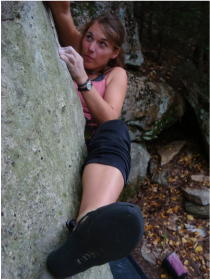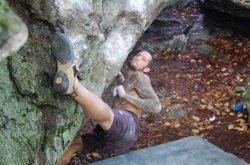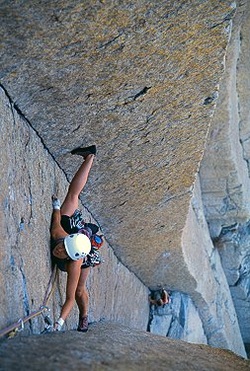Flagging
Flagging is an incredibly useful technique and quite necessary if you're pushing into more intermediate climbs. When flagging, you use one limb (usually a leg) to point and balance your weight in order to keep from swinging out from the rock (i.e. barn dooring) or extend in the opposite direction of where the limb is pointing. You are not using this leg for support, but rather using it to shift your center of balance. It usually is not touching the rock. This is useful on big, reachy moves and allows you to gain a bit more span with your body without expending too much extra energy. This technique is also necessary when a right hand/foot combo is not possible. If you don't flag when you don't have a good hand/foot combo on one side, you'll notice that your body wants to swing out towards the side that is more solidly positioned on the rock. This is known as the "barn door" effect. If you flag with the foot that doesn't have a good hold and point it towards the side of your body that is solid, while maintaining body and leg tension, your barn door will be easier to keep shut. Both climbers in the videos above use flagging; watching their technique is a good way to incorporate it into your climbing.
Heel Hook

A heel hook involves you placing the heel of your foot on a hold that is usually waist level or higher. The move is most useful in situations where there is an arete or an overhang. The heel hook helps you keep your balance and can also provide important leverage for moving your hands and body higher up the route. Also, the heel hook looks awesome - so use it!
Toe Hook

Toe hooks are great for keeping your center of gravity pulled in towards the rock and they give you balance and leverage for moving up. You can use a toe hook on an arete, side pulls, or on underclings. To place a toe hook, you use the top part of your toe (that's why they put rubber there!) to pull sideways against an arete or side pull or you can pull inward on an undercling to help keep your body from swinging out. They aren't quite as flashy as toe hooks, but they are incredibly useful and actually have a better transition than the heel hook. As you move up and above your toe hook, your foot easily transitions into using the hold to step up.
Stemming

Stemming is great - it feels awesome, doesn't require a ton of strength and takes some creativity to master. When stemming, you use the tension of your body to move upwards while pushing on holds. Stemming is most useful in a dihedral (a.k.a. an inside corner) where you have holds on the left-facing wall and the right-facing wall and your body follows the line of the corner. The climber in the photo is utilizing the oppsotional force generated by pushing her feet into the two opposing walls to stay on the rock. She looks a little over-extended in the photo, meaning that she will probably have a hard time moving to the next hand hold because she has little extension left in her body. Most likely, she used this position go get a much needed rest, asses her next move, or get a slight advantage upward to a handhold barely out of reach.
Stemming requires some balance, technique and flexibility, but once you get it, it feels awesome (and looks good too!).
Stemming requires some balance, technique and flexibility, but once you get it, it feels awesome (and looks good too!).